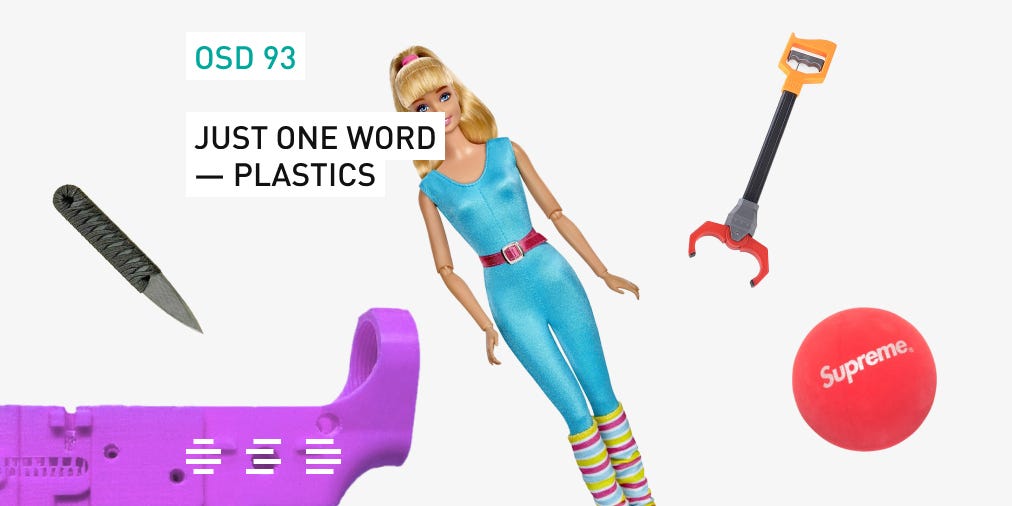OSD 93: Just one word — plastics
The end of centrally-controlled filter bubbles.
This week a journalism collective called Popular Front released Plastic Defence, “a documentary about illegal 3D-printed firearms in Europe and the decentralised network behind them”.
3D-printed guns embody two broad themes that recur often in this newsletter. The first are the widely-discussed cypherpunk ideas that technology is fundamentally uncontrollable over time, that information wants to be free, and so on. And that’s all of course true — the genie’s not going back into the bottle, and the whole debate over whether in principle the genie should be locked up is a moot irrelevance now.
The second theme is less often discussed, and has some explanatory power for why guns are a touchy subject. Technology makes it so that physical objects can be transmitted like ideas. And ideas are the fundamentally dangerous thing. A couple years ago, one of the OSD cofounders wrote an essay on the cultural dynamics around guns. It included this passage:
Both sides go through the motions of an Oxford-style debate, but judging by their actions, they know persuasion doesn’t work. The actions don’t match a debate. They match a culture war. And those … well, those you win by force.
What does winning by force look like? One example is that the states have bifurcated hard on gun laws since the mid-1980s.
The states that operate from a gun-rights frame have gotten much less restrictive. In 1986, nine states had shall-issue concealed carry permits. Today, 42 states have them, and 13 of those don’t even require a permit at all. That wave grew geometrically.
Similarly, states with a gun-control frame have gotten much more restrictive. For example, in six out of the seven states with assault weapons bans, the bans’ provisions have ratcheted tighter and tighter every 10–15 years.
The force driving this is that when persuasion doesn’t work, the dominant strategy is to use a greedy algorithm: anywhere you can win, take it immediately. Doesn’t matter if it makes sense or even if you really care that much about it. If it upsets the other side, you do it.
Those are textbook culture war dynamics: there is no middle. Fencesitters have to pick a side even if they don’t want to, just for self-defense. So states picked their separate directions and floored the gas pedal. Given their geographical separation, that would be a stable equilibrium. Except there’s one last step before you win a culture war:
To win permanently, you have to eliminate the other side’s ideas. That’s why gun control groups lobbied YouTube to ban videos showing magazines that hold more than 30 rounds. Or why gun rights groups want 18-year-olds to be able to buy rifles. The policy specifics aren’t why people get so worked up.
Here’s why people really care: one side wants to be normalized and the other side wants them to be stigmatized. That’s zero-sum. Every point—bump stocks, Citigroup, mag capacity, YouTube—is a cultural altercation about what is normal versus what is shameful.
One side has an attachment (individual ownership of weapons qua weapons, unconnected to recreation) they view as healthy, essential, and normal. In their culture, it is normal. The other side sees it as deeply repulsive and shameful. In their culture, it is.
Again, that would be a stable equilibrium in a world where mass communication didn’t exist. But it does exist, so ideas that you expelled can still “contaminate” your culture from afar. That’s why this is so acrimonious. Each side truly believes the other side’s ideas should not exist.
The powerful thing about 3D-printed guns is the same thing that’s powerful about the computer network that transmits them (i.e. the Internet): it becomes impossible for centralized decision-makers to keep ideas out of a culture’s information bubble. They’re going to get in, one way or another. And what happens after that will be dictated by how people respond to learning more about the idea. As we’ve dived into before, that tends to go well for gun rights.
This week’s links
Judge Bibas on the Third Circuit Court of Appeals dissents from a ruling upholding the lifetime gun possession ban for convicted felons
Felons are more than the wrongs they have done. They are people and citizens who are part of ‘We the People of the United States.’ So they too share in the Second Amendment ‘right of the people to keep and bear Arms,’ subject only to the historical limits on that right.
Judge Bibas also wrote a great dissent in 2018, dissenting from a ruling that upheld New Jersey’s ban on standard-capacity magazines.
Apple’s head of security indicted for paying the sheriff’s office (in iPads) to obtain concealed carry permits
Indicted: the people who were extorted by the sheriff’s office into buying back their rights.
Not indicted: the sheriff.
🤔
Gun rights are winning and nobody has realized it
There was a new wave of attention this week to this essay we wrote in the summer of 2019. The link above goes to this week’s reddit discussion of the piece, and here’s the essay itself. And here’s a Twitter thread we wrote this week expanding on some of the themes.
OSD Office Hours
If you’re a new gun owner, thinking about becoming one, or know someone who is, click here to come to OSD Office Hours. It’s a free 30-minute video call with an OSD team member to ask any and all your questions.
Merch and coffee
We’ve got merch that you’ll want to wear. Check it out.
If you like this newsletter, you can support OSD instantly on our Buy Me a Coffee page. It’s a dead-simple way to kick in a few bucks to help us keep growing like crazy.


